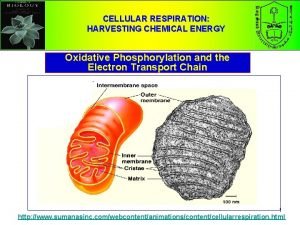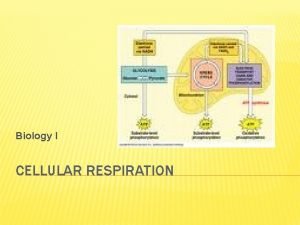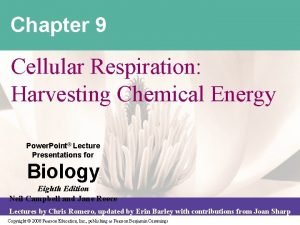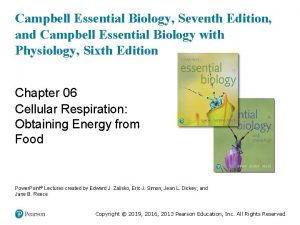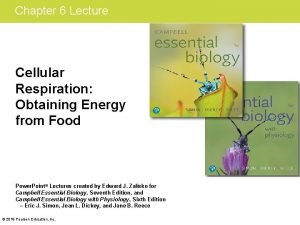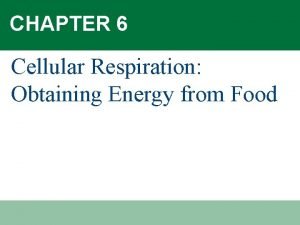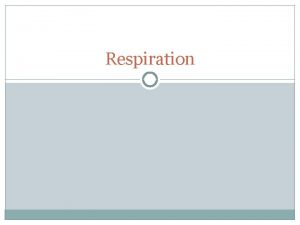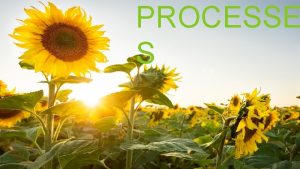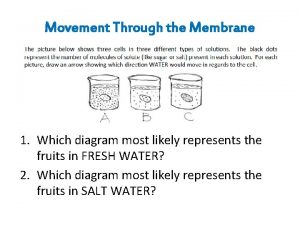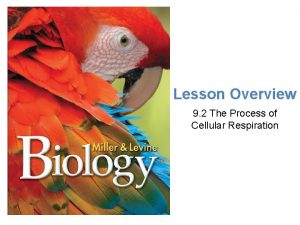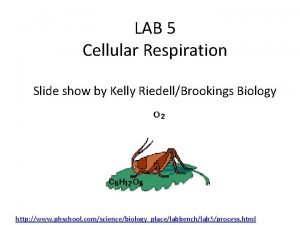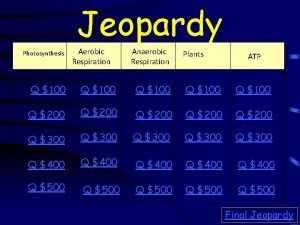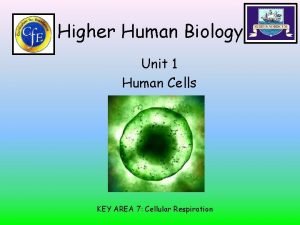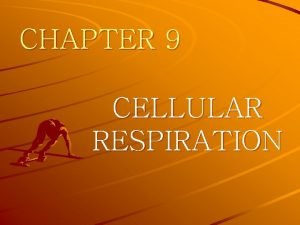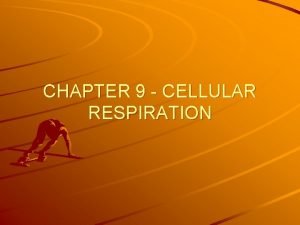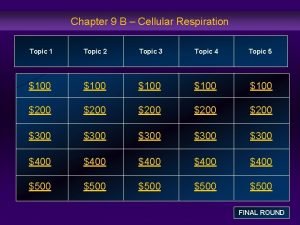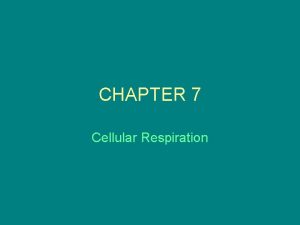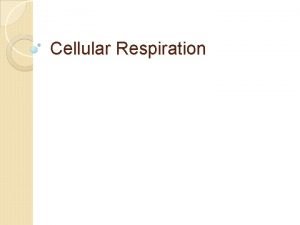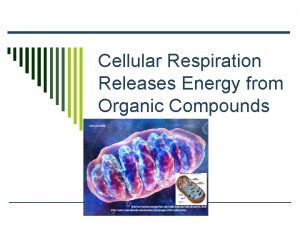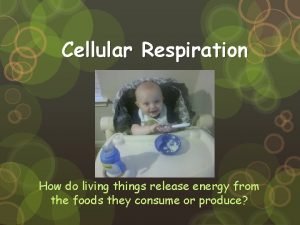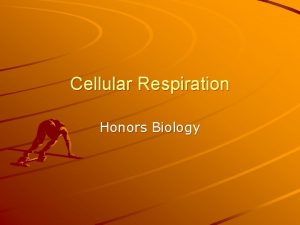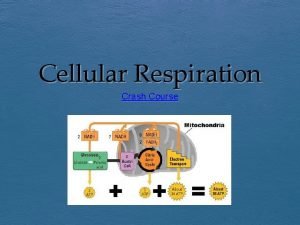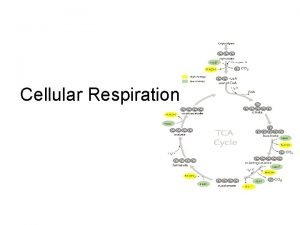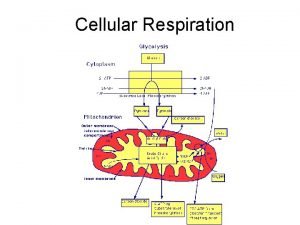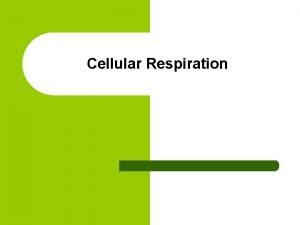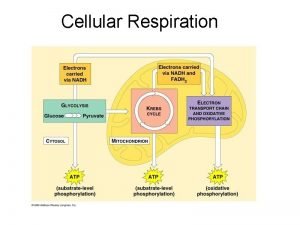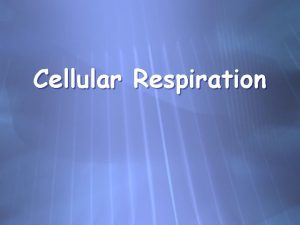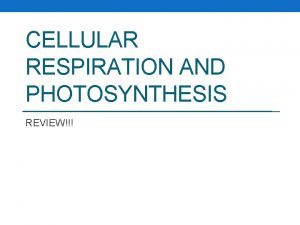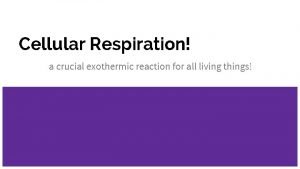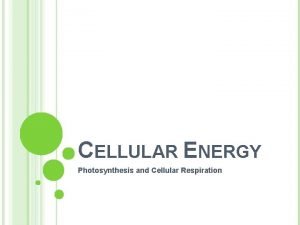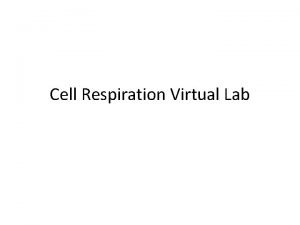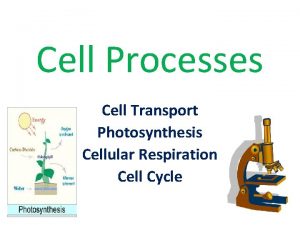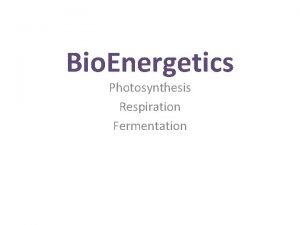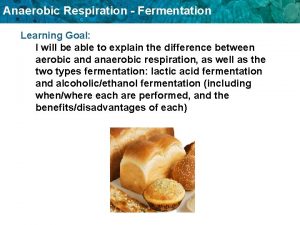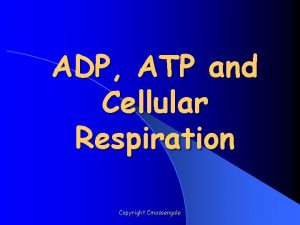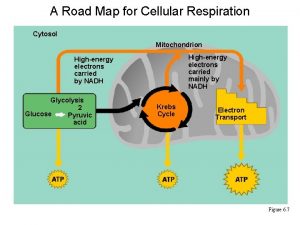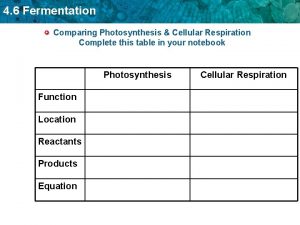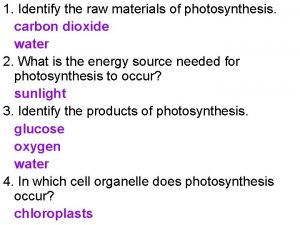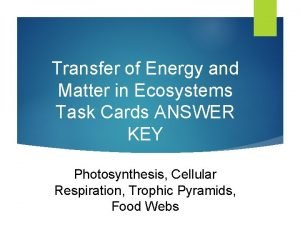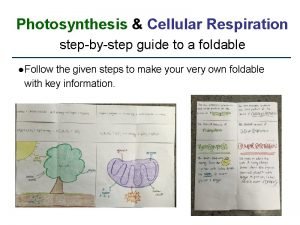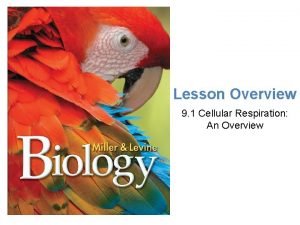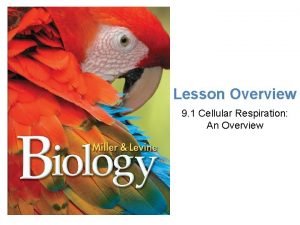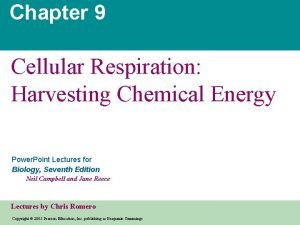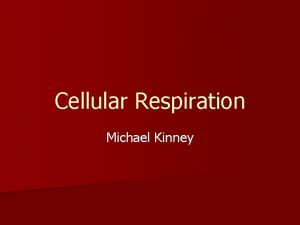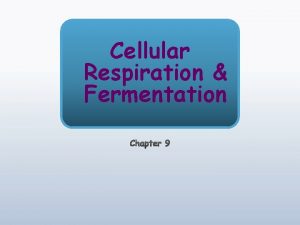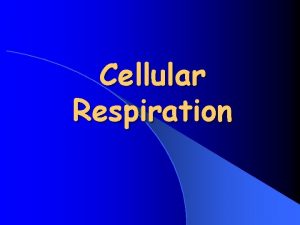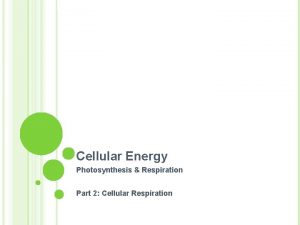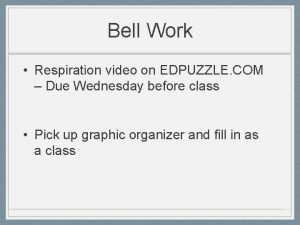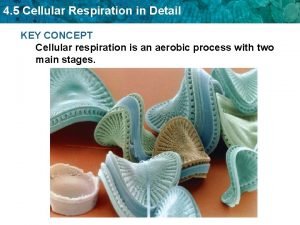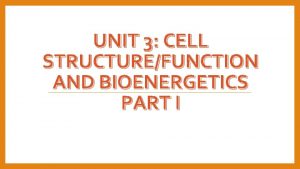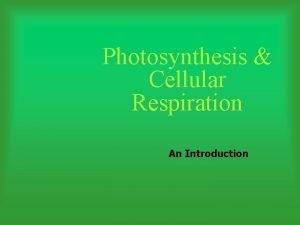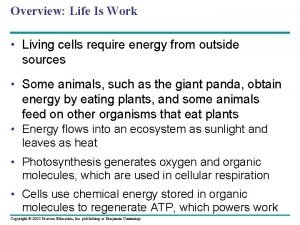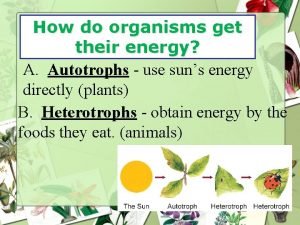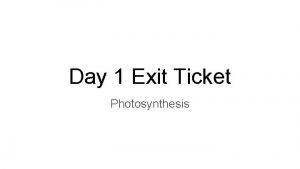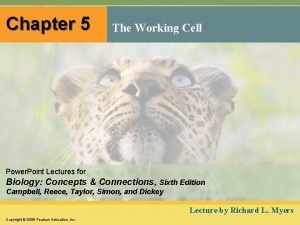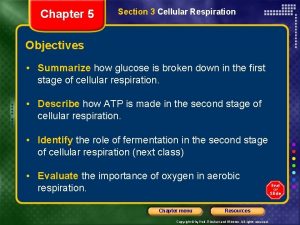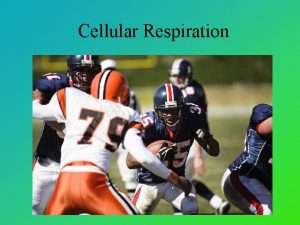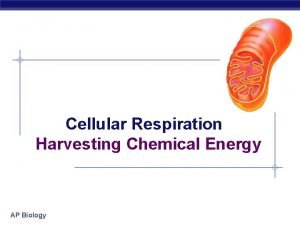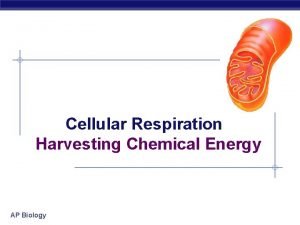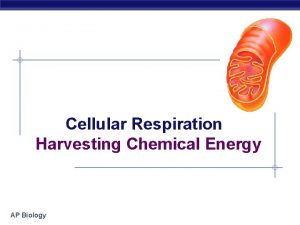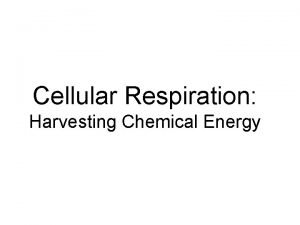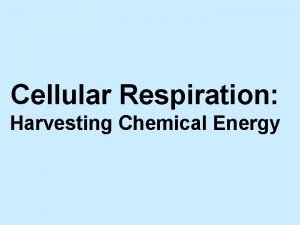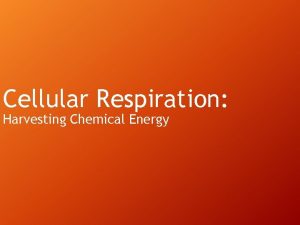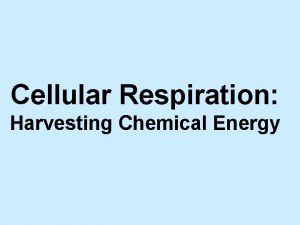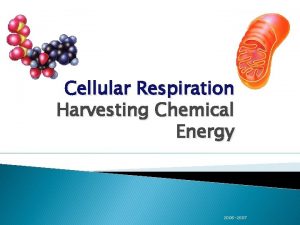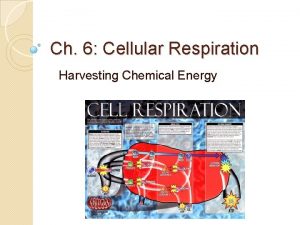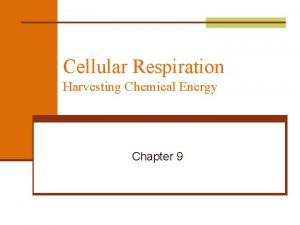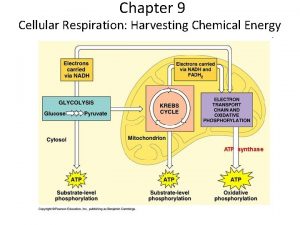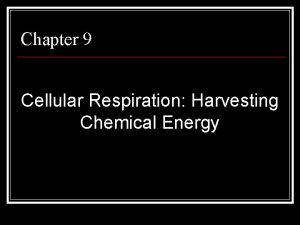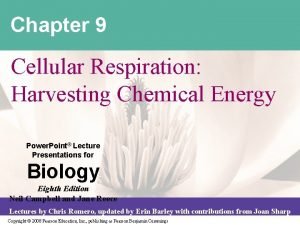Chapter 9 Cellular Respiration Harvesting Chemical Energy Power












































































- Slides: 76

Chapter 9 Cellular Respiration: Harvesting Chemical Energy Power. Point® Lecture Presentations for Biology Eighth Edition Neil Campbell and Jane Reece Lectures by Chris Romero, updated by Erin Barley with contributions from Joan Sharp Copyright © 2008 Pearson Education, Inc. , publishing as Pearson Benjamin Cummings

You should be able to: 1. Define oxidation and reduction. 2. Explain in general terms how redox reactions are involved in energy exchanges. 3. Name three stages of cellular respiration; for each, state the region of the eukaryotic cell where it occurs and the products that result. 4. In general terms, explain the role of the electron transport chain in cellular respiration. Copyright © 2008 Pearson Education, Inc. , publishing as Pearson Benjamin Cummings

5. How are coenzymes used in cellular respiration? 6. Explain where and how the respiratory electron transport chain creates a proton gradient. 7. Distinguish between fermentation and anaerobic respiration. 8. Distinguish between obligate and facultative anaerobes. Copyright © 2008 Pearson Education, Inc. , publishing as Pearson Benjamin Cummings

Living cells require energy from outside sources. The giant panda obtains energy by eating plants. Other animals feed on organisms that eat plants.

Fig. 9 -2 Light energy Energy flows into an ecosystem as sunlight and leaves as heat ECOSYSTEM Photosynthesis in chloroplasts CO 2 + H 2 O Organic + O 2 molecules Photosynthesis generates O 2 and organic molecules, which are used in cellular respiration Cellular respiration in mitochondria ATP powers most cellular work Heat energy Cells use chemical energy stored in organic molecules to regenerate ATP, which powers work

Concept 9. 1: Catabolic pathways yield energy by oxidizing organic fuels • Several processes are central to cellular respiration and related pathways Copyright © 2008 Pearson Education, Inc. , publishing as Pearson Benjamin Cummings

Catabolic pathways yield energy by oxidizing organic fuels • The breakdown of organic molecules is exergonic • Fermentation is a partial degradation of sugars that occurs without O 2 • Aerobic respiration consumes organic molecules and O 2 and yields ATP • Anaerobic respiration is similar to aerobic respiration but consumes compounds other than O 2 Copyright © 2008 Pearson Education, Inc. , publishing as Pearson Benjamin Cummings

• Cellular respiration includes both aerobic and anaerobic respiration but is often used to refer to aerobic respiration • Although carbohydrates, fats, and proteins are all consumed as fuel, it is helpful to trace cellular respiration with the sugar glucose: C 6 H 12 O 6 + 6 O 2 6 CO 2 + 6 H 2 O + Energy (ATP + heat) Copyright © 2008 Pearson Education, Inc. , publishing as Pearson Benjamin Cummings

Redox Reactions: Oxidation and Reduction • The transfer of e-s during chem rxns releases E stored in organic molecules • This released E is ultimately used to synthesize ATP Copyright © 2008 Pearson Education, Inc. , publishing as Pearson Benjamin Cummings

The Principle of Redox • Chemical rxns that transfer e-s between reactants (and release E from organic molecules) are called oxidation-reduction rxns, or redox rxns • This released E is ultimately used to synthesize ATP • In oxidation, a substance loses e-s, or is oxidized • In reduction, a substance gains e-s, or is reduced (the amount of + charge is reduced becomes more negative) Copyright © 2008 Pearson Education, Inc. , publishing as Pearson Benjamin Cummings

Fig. 9 -UN 1 becomes oxidized (loses e-) becomes reduced (gains e-)

Fig. 9 -UN 2 becomes oxidized becomes reduced

Oxidation of Organic Fuel-Molecules During Cellular Respiration (CR) • During CR, the fuel (such as glucose) is oxidized, and O 2 is reduced: becomes oxidized becomes reduced Copyright © 2008 Pearson Education, Inc. , publishing as Pearson Benjamin Cummings

Stepwise Energy Harvest via NAD+ and the Electron Transport Chain (ETC) • In CR, glucose and other organic molecules are broken down in a series of steps • e-s from organic cmpds are usually first transferred to NAD+, a coenzyme • As an electron acceptor, NAD+ fxns as an oxidizing agent during CR • Each NADH (the reduced form of NAD+) represents stored E that is tapped to synthesize ATP Copyright © 2008 Pearson Education, Inc. , publishing as Pearson Benjamin Cummings

Fig. 9 -UN 4 Dehydrogenase

Fig. 9 -4 2 e– + 2 H+ 2 e– + H+ NADH H+ Dehydrogenase NAD+ + 2[H] Reduction of NAD+ + H+ Oxidation of NADH Nicotinamide (reduced form) Nicotinamide (oxidized form)

• NADH passes the e-s to the electron transport chain, ETC • Unlike an uncontrolled rxn, the ETC passes e-s in a series of steps instead of one explosive rxn • O 2 pulls e-s down the chain in an E-yielding tumble • The E yielded is used to regenerate ATP Copyright © 2008 Pearson Education, Inc. , publishing as Pearson Benjamin Cummings

The Stages of Cellular Respiration: A Preview • CR has three stages: – Glycolysis (breaks down glucose into 2 molecules of pyruvate) – The citric acid cycle (completes the breakdown of glucose) – Oxidative phosphorylation (accounts for most of the ATP synthesis) Copyright © 2008 Pearson Education, Inc. , publishing as Pearson Benjamin Cummings

Fig. 9 -6 -1 Electrons carried via NADH Glycolysis Pyruvate Glucose Cytosol ATP Substrate-level phosphorylation

Fig. 9 -6 -2 Electrons carried via NADH and FADH 2 Electrons carried via NADH Citric acid cycle Glycolysis Pyruvate Glucose Mitochondrion Cytosol ATP Substrate-level phosphorylation

Fig. 9 -6 -3 Electrons carried via NADH and FADH 2 Electrons carried via NADH Citric acid cycle Glycolysis Pyruvate Glucose Oxidative phosphorylation: electron transport and chemiosmosis Mitochondrion Cytosol ATP ATP Substrate-level phosphorylation Oxidative phosphorylation

• The process that generates most of the ATP is called oxidative phosphorylation because it is powered by redox rxns Copyright © 2008 Pearson Education, Inc. , publishing as Pearson Benjamin Cummings

• Oxidative phosphorylation accounts for almost 90% of the ATP generated by CR • A smaller amt of ATP is formed in glycolysis and the citric acid cycle by substrate-level phosphorylation Copyright © 2008 Pearson Education, Inc. , publishing as Pearson Benjamin Cummings

Concept 9. 2: Glycolysis harvests chemical energy by oxidizing glucose to pyruvate • Glycolysis (“splitting of sugar”) breaks down glucose into 2 molecules of pyruvate • Glycolysis occurs in the cytoplasm and has two major phases: – Energy investment phase – Energy payoff phase Can occur whether O 2 is present or not! Copyright © 2008 Pearson Education, Inc. , publishing as Pearson Benjamin Cummings

Fig. 9 -8 Energy investment phase 2 ATP provides EA by phosphorylating glucose Glucose 2 ADP + 2 P 2 ATP used 4 ATP formed Energy payoff phase 4 ADP + 4 P 2 NAD+ + 4 e– + 4 H+ 2 NADH + 2 H+ 2 Pyruvate + 2 H 2 O Net Glucose 4 ATP formed – 2 ATP used 2 NAD+ + 4 e– + 4 H+ 2 Pyruvate + 2 H 2 O 2 ATP 2 NADH + 2 H+ NADH passes the e-s to the ETC

Fig. 9 -9 -1 Glucose ATP 1 Hexokinase ADP Glucose-6 -phosphate

Fig. 9 -9 -2 Glucose ATP 1 Hexokinase ADP Glucose-6 -phosphate 2 Phosphoglucoisomerase Fructose-6 -phosphate

Fig. 9 -9 -3 Glucose ATP 1 Hexokinase AD P Fructose-6 -phosphate Glucose-6 -phosphate 2 Phosphoglucoisomerase ATP 3 Phosphofructokinase Fructose-6 -phosphate ATP 3 Phosphofructokinase ADP AD P Fructose 1, 6 -bisphosphate

Fig. 9 -9 -4 Glucose ATP 1 Hexokinase AD P Glucose-6 -phosphate 2 Phosphoglucoisomerase Fructose 1, 6 -bisphosphate 4 Fructose-6 -phosphate ATP Aldolase 3 Phosphofructokinase AD P 5 Isomerase Fructose 1, 6 -bisphosphate 4 Aldolase 5 Isomerase Dihydroxyacetone phosphate Glyceraldehyde 3 -phosphate

Fig. 9 -9 -5 2 NAD+ 2 NADH + 2 H+ 6 Triose phosphate dehydrogenase 2 Pi 2 1, 3 -Bisphoglycerate Glyceraldehyde 3 -phosphate 2 NAD+ 2 NADH 6 Triose phosphate dehydrogenase 2 Pi + 2 H+ 2 1, 3 -Bisphoglycerate

Fig. 9 -9 -6 2 NAD+ 2 NADH + 2 H+ 6 Triose phosphate dehydrogenase 2 Pi 2 1, 3 -Bisphoglycerate 2 ADP 7 Phosphoglycerokinase 2 ATP 2 1, 3 -Bisphoglycerate 2 ADP 2 3 -Phosphoglycerate 2 ATP 2 7 Phosphoglycerokinase 3 -Phosphoglycerate

Fig. 9 -9 -7 2 NAD+ 2 NADH + 2 H+ 6 Triose phosphate dehydrogenase 2 Pi 2 1, 3 -Bisphoglycerate 2 ADP 7 Phosphoglycerokinase 2 ATP 2 3 -Phosphoglycerate 8 2 3 -Phosphoglycerate Phosphoglyceromutase 2 8 Phosphoglyceromutase 2 -Phosphoglycerate 2 2 -Phosphoglycerate

Fig. 9 -9 -8 2 NAD+ 2 NADH + 2 H+ 6 Triose phosphate dehydrogenase 2 Pi 2 1, 3 -Bisphoglycerate 2 ADP 7 Phosphoglycerokinase 2 ATP 2 3 -Phosphoglycerate 2 2 -Phosphoglycerate 8 Phosphoglyceromutase 2 9 2 H 2 O 2 -Phosphoglycerate Enolase 9 2 H 2 O 2 Enolase Phosphoenolpyruvate 2 Phosphoenolpyruvate

Fig. 9 -9 -9 2 NAD+ 2 NADH + 2 H+ 6 Triose phosphate dehydrogenase 2 Pi 2 1, 3 -Bisphoglycerate 2 ADP 7 Phosphoglycerokinase 2 ATP 2 Phosphoenolpyruvate 2 ADP 2 3 -Phosphoglycerate 8 10 Pyruvate kinase Phosphoglyceromutase 2 ATP 2 2 -Phosphoglycerate 9 2 H 2 O Enolase 2 Phosphoenolpyruvate 2 ADP 10 Pyruvate kinase 2 ATP 2 2 Pyruvate The starting matl for the Krebs cycle

Glycolysis: Inputs and Outputs Copyright © The Mc. Graw-Hill Companies, Inc. Permission required for reproduction or display inputs Glycolysis outputs glucose 2 pyruvate 2 NADH 2 NAD+ 2 ATP 2 ADP 4 ADP + 4 P 4 ATP total 2 ATP net gain 35

Concept 9. 3: The citric acid cycle completes the energy-yielding oxidation of organic molecules • In the presence of O 2, pyruvate enters the mitochondrion. • Before the citric acid cycle can begin, pyruvate must be converted to acetyl Co. A, which links the cycle to glycolysis Copyright © 2008 Pearson Education, Inc. , publishing as Pearson Benjamin Cummings

Fig. 9 -10 CYTOSOL MITOCHONDRION NAD+ NADH + H+ 2 1 Pyruvate Transport protein 3 CO 2 Coenzyme A Acetyl Co. A

Fig. 9 -11 Pyruvate The citric acid cycle, also called the Krebs cycle, takes place within the mitochondrial matrix CO 2 NAD+ Co. A NADH + H+ Acetyl Co. A Citric acid cycle FADH 2 2 2 CO 2 3 NAD+ FAD 3 NADH + 3 H+ ADP + P i ATP The cycle oxidizes CO organic fuel derived from pyruvate, generating 1 ATP, 3 NADH, and 1 FADH 2 per turn (X 2=2 ATP, 6 NADH and 2 FADH 2)

• The citric acid cycle has eight steps, each catalyzed by a specific • The acetyl group of acetyl Co. A joins the cycle by combining with oxaloacetate, forming citrate • The next 7 steps decompose the citrate back to oxaloacetate, making the process a cycle ☺The NADH and FADH 2 produced by the cycle relay e-s extracted from glucose to the ETC. The sole purpose of the Krebs cycle is to produce the e- carriers. Copyright © 2008 Pearson Education, Inc. , publishing as Pearson Benjamin Cummings

Fig. 9 -12 -8 Acetyl Co. A—SH NADH +H+ H 2 O 1 NAD+ 8 Oxaloacetate 2 Malate Citrate Isocitrate NAD+ H 2 O Citric acid cycle 7 Fumarate NADH + H+ 3 CO 2 Co. A—SH 6 -Ketoglutarate 4 Co. A—SH 5 FADH 2 NAD+ FAD Succinate GTP GDP ATP Pi Succinyl Co. A NADH + H+ CO 2

Citric Acid Cycle: Balance Sheet Copyright © The Mc. Graw-Hill Companies, Inc. Permission required for reproduction or display. inputs Citric acid cycle outputs 4 CO 2 6 NADH 2 acetyl groups 6 NAD+ 2 FAD 2 ADP + 2 P 2 FADH 2 2 ATP

Concept 9. 4: During oxidative phosphorylation, chemiosmosis couples electron transport to ATP synthesis • Following glycolysis and the citric acid cycle, NADH and FADH 2 account for most of the E extracted from food • These two e- carriers donate e-s to the ETC, which powers ATP synthesis by oxidative phosphorylation Copyright © 2008 Pearson Education, Inc. , publishing as Pearson Benjamin Cummings

• The ETC is a collection of molecules embedded in the cristae of the mitochondrion ↑d SA for thousands of ETCs per mitochondrion. Copyright © 2008 Pearson Education, Inc. , publishing as Pearson Benjamin Cummings

• Most of the chain’s components are proteins • The carriers alternate between reduced and oxidized states as they accept and donate e-s • e-s drop in free E as they go down the chain and are finally passed to O 2, forming H 2 O – Each O-atom picks up a pair of H+ ions H 2 O

Fig. 9 -13 page 173 NADH 50 2 e– NAD+ FADH 2 2 e– Free energy (G) relative to O 2 (kcal/mol) 40 FMN FAD Multiprotein complexes FAD Fe • S Q Cyt b 30 Fe • S Cyt c 1 IV Cyt c Cyt a 20 10 0 Cyt a 3 2 e– (from NADH or FADH 2) 2 H+ + 1/2 O 2 H 2 O

• e-s are transferred from NADH or FADH 2 to the ETC • e-s are passed through a number of proteins including cytochromes (each with an Fe-atom) to O 2 • The ETC generates NO ATP directly – simply establishes the H+ ion gradient • The chain’s fxn is to break the large amt of E in food into manageable amts – To ease the fall of e-s from food to O 2 Copyright © 2008 Pearson Education, Inc. , publishing as Pearson Benjamin Cummings

Chemiosmosis: The Energy-Coupling Mechanism • e- transfer in the ETC causes proteins to pump H+ from the mitochondrial matrix to the intermembrane space • H+ then moves back across the membrane, passing through channels in ATP synthase • ATP synthase uses the exergonic flow of H+ to drive phosphorylation of ATP • This is an example of chemiosmosis - the use of E in a H+ gradient to drive cellular work Copyright © 2008 Pearson Education, Inc. , publishing as Pearson Benjamin Cummings

• The E stored in a H+ gradient across a membrane couples the redox rxns of the ETC to ATP synthesis • The H+ gradient is referred to as a protonmotive force, emphasizing its capacity to do work Copyright © 2008 Pearson Education, Inc. , publishing as Pearson Benjamin Cummings

Fig. 9 -16 H+ H+ H+ Protein complex of electron carriers H+ Cyt c V Q FADH 2 NADH ATP synthase FAD 2 H+ + 1/2 O 2 NAD+ H 2 O ADP + P i (carrying electrons from food) ATP H+ 1 Electron transport chain Oxidative phosphorylation 2 Chemiosmosis


An Accounting of ATP Production by Cellular Respiration • During CR, most E flows in this sequence: glucose NADH ETC proton-motive force ATP • About 40% of the E in a glucose molecule is transferred to ATP during CR, making ~38 ATP Copyright © 2008 Pearson Education, Inc. , publishing as Pearson Benjamin Cummings

Fig. 9 -17 Electron shuttles span membrane CYTOSOL 2 NADH Glycolysis Glucose 2 Pyruvate MITOCHONDRION 2 NADH or 2 FADH 2 6 NADH 2 Acetyl Co. A + 2 ATP Citric acid cycle + 2 ATP Maximum per glucose: About 36 or 38 ATP 2 FADH 2 Oxidative phosphorylation: electron transport and chemiosmosis + about 32 or 34 ATP

Overall Energy Yielded per Glucose Molecule Copyright © The Mc. Graw-Hill Companies, Inc. Permission required for reproduction or display. 2 net ATP glycolysis 2 NADH 6 NADH 2 FADH 2 pyruvate Mitochondrion 2 acetyl Co. A 2 CO 2 2 ATP Citric acid cycle 4 CO 2 ATP 6 ATP 18 ATP 4 ATPP 2 6 O 2 subtotal 4 4 or 6 Electron transport chain Cytoplasm glucose 6 H 2 O subtotal 32 or 34 ATP 36 or 38 total ATP 53

54

55

Concept 9. 5: Fermentation and anaerobic respiration enable cells to produce ATP without the use of oxygen • Most CR requires O 2 to produce ATP • Glycolysis can produce ATP with or w/o O 2 (in aerobic or anaerobic conditions) • In the absence of O 2, glycolysis couples with fermentation or anaerobic respn to produce ATP Copyright © 2008 Pearson Education, Inc. , publishing as Pearson Benjamin Cummings

How is NADH recycled to NAD+? Another molecule must accept H from NADH H 2 O O 2 recycle NADH without oxygen with oxygen anaerobic respiration “fermentation” pyruvate NAD+ NADH acetyl-Co. A CO 2 NADH NAD+ lactate which path you use depends on who you are… acetaldehyde NADH NAD+ lactic acid fermentation Krebs cycle ethanol alcohol fermentation

• Anaerobic respiration uses an ETC with an eacceptor other than O 2 (sulfate) • Fermentation uses phosphorylation instead of an ETC to generate ATP Copyright © 2008 Pearson Education, Inc. , publishing as Pearson Benjamin Cummings

Types of Fermentation • Fermentation consists of glycolysis plus rxns that regenerate NAD+, which can be reused by glycolysis – alcohol fermentation – lactic acid fermentation Copyright © 2008 Pearson Education, Inc. , publishing as Pearson Benjamin Cummings

• In alcohol fermentation, pyruvate is converted to ethanol in two steps, with the first releasing CO 2 • Alcohol fermentation by yeast is used in brewing, winemaking, and baking Copyright © 2008 Pearson Education, Inc. , publishing as Pearson Benjamin Cummings

Alcohol Fermentation bacteria yeast pyruvate ethanol + CO 2 3 C NADH § Dead end process 2 C NAD+back to glycolysis § at ~12% ethanol yeast cells die § can’t reverse the rxn Count the carbons! 1 C recycle NADH

Fermentation (anaerobic) • Bacteria, yeast pyruvate ethanol + CO 2 3 C NADH § beer, wine, bread 2 C NAD+ 1 C back to glycolysis § Animals, some fungi pyruvate lactic acid 3 C NADH 3 C NAD+ back to glycolysis § cheese, anaerobic exercise (no O 2)

• In lactic acid fermentation, pyruvate is reduced to NADH, forming lactate as an end product, with no release of CO 2 • Lactic acid fermentation by some fungi and bacteria is used to make cheese and yogurt • Human muscle cells use lactic acid fermentation to generate ATP when O 2 is scarce Copyright © 2008 Pearson Education, Inc. , publishing as Pearson Benjamin Cummings

animals some fungi Lactic Acid Fermentation pyruvate lactic acid 3 C NADH 3 C NAD+back to glycolysis § Reversible process § once O 2 is available, lactate is converted back to pyruvate by the liver Count the carbons! O 2 recycle NADH

Fermentation and Aerobic Respiration Compared • Both processes use glycolysis to oxidize glucose and other organic fuels to pyruvate • The processes have different final e- acceptors: an organic molecule (such as pyruvate or acetaldehyde) in fermentation and O 2 in CR • CR 38 ATP per glucose molecule; fermentation 2 ATP per glucose molecule Copyright © 2008 Pearson Education, Inc. , publishing as Pearson Benjamin Cummings

• Obligate anaerobes carry out fermentation or anaerobic respn and cannot survive in the presence of O 2 • Yeast and many bacteria are facultative anaerobes, meaning that they can survive using either fermentation or CR • In a facultative anaerobe, pyruvate is a fork in the metabolic road that leads to 2 alternative catabolic routes Copyright © 2008 Pearson Education, Inc. , publishing as Pearson Benjamin Cummings

Fig. 9 -19 Glucose CYTOSOL Glycolysis Pyruvate No O 2 present: Fermentation O 2 present: Aerobic cellular respiration MITOCHONDRION Ethanol or lactate Acetyl Co. A Citric acid cycle

The Evolutionary Significance of Glycolysis • Glycolysis occurs in nearly all organisms – probably evolved in ancient prokaryotes before there was O 2 in the atm Copyright © 2008 Pearson Education, Inc. , publishing as Pearson Benjamin Cummings

Concept 9. 6: Glycolysis and the citric acid cycle connect to many other metabolic pathways • Gycolysis and the citric acid cycle are major intersections to various catabolic and anabolic pathways Copyright © 2008 Pearson Education, Inc. , publishing as Pearson Benjamin Cummings

Pyruvate is a branching point Pyruvate O 2 fermentation anaerobic respn mitochondria Krebs cycle aerobic respn

The Versatility of Catabolism • Catabolic pathways funnel e-s from many kinds of organic molecules into CR • Glycolysis accepts a wide range of carbohydrates • Proteins must be digested to amino acids; amino groups can feed glycolysis or the citric acid cycle Copyright © 2008 Pearson Education, Inc. , publishing as Pearson Benjamin Cummings

• Fats are digested to glycerol (used in glycolysis) and fatty acids (used in generating acetyl Co. A) • Fatty acids are broken down by beta oxidation and yield acetyl Co. A • An oxidized gram of fat more than 2 X as much ATP as an oxidized gram of carb – 9 k. Cal vs 4 k. Cal Copyright © 2008 Pearson Education, Inc. , publishing as Pearson Benjamin Cummings

Fig. 9 -20 Proteins Amino acids Carbohydrates Sugars Glycolysis Glucose Glyceraldehyde-3 - P NH 3 Pyruvate Acetyl Co. A Citric acid cycle Oxidative phosphorylation Fats Glycerol Fatty acids

Biosynthesis (Anabolic Pathways) • The body uses small molecules to build other substances • These small molecules may come directly from food, from glycolysis, or from the citric acid cycle Copyright © 2008 Pearson Education, Inc. , publishing as Pearson Benjamin Cummings

Taking it beyond… • What is the final e- acceptor in. H ETC? H + H+ + C e– O 2 NADH Q e– FADH 2 FAD NAD+ NADH dehydrogenase e– 1 2 H+ +2 O 2 cytochrome bc complex § So what happens if O 2 unavailable? § ETC backs up nothing to pull e-s down chain u NADH & FADH 2 can’t unload H+ u § ATP production ceases § cells run out of E § and you die! H 2 O cytochrome c oxidase complex

Regulation of Cellular Respiration via Feedback Mechanisms • Feedback inhibition is the most common mechanism for control • If [ATP] begins to drop, respn speeds up; when there is plenty of ATP, respn slows down • Control of catabolism is based mainly on regulating the activity of s at strategic points in the catabolic pathway Copyright © 2008 Pearson Education, Inc. , publishing as Pearson Benjamin Cummings
 Chapter 9: cellular respiration: harvesting chemical energy
Chapter 9: cellular respiration: harvesting chemical energy Explain how amp stimulates cellular respiration
Explain how amp stimulates cellular respiration Chapter 9: cellular respiration: harvesting chemical energy
Chapter 9: cellular respiration: harvesting chemical energy Electron transport chain summary
Electron transport chain summary Cellular respiration chemical equation
Cellular respiration chemical equation Summary equation for cellular respiration
Summary equation for cellular respiration Word equation for cell respiration
Word equation for cell respiration Energy flow in cellular respiration
Energy flow in cellular respiration Energy flow in cellular respiration
Energy flow in cellular respiration Cellular respiration obtaining energy from food
Cellular respiration obtaining energy from food Cellular respiration obtaining energy from food
Cellular respiration obtaining energy from food Chapter 8 section 3: cellular respiration
Chapter 8 section 3: cellular respiration Chapter 8 section 1: how organisms obtain energy
Chapter 8 section 1: how organisms obtain energy Cellular respiration redox
Cellular respiration redox What is the correct equation for cellular respiration?
What is the correct equation for cellular respiration? Cellular respiration steps
Cellular respiration steps Where is aerobic respiration located
Where is aerobic respiration located Was ist fermentiert
Was ist fermentiert Why is cellular respiration important
Why is cellular respiration important The process of photosynthesis and cellular respiration
The process of photosynthesis and cellular respiration Cellular respiration reactants
Cellular respiration reactants Equation for photosynthesis
Equation for photosynthesis Photosynthesis recipe card
Photosynthesis recipe card Electron carriers in cellular respiration
Electron carriers in cellular respiration Overview of cellular respiration
Overview of cellular respiration Overview of respiration
Overview of respiration Cellular respiration
Cellular respiration Overview of cellular respiration
Overview of cellular respiration Lab bench cellular respiration
Lab bench cellular respiration What is the word equation for cellular respiration
What is the word equation for cellular respiration Higher human biology cellular respiration
Higher human biology cellular respiration What are the reactants and products of photosynthesis?
What are the reactants and products of photosynthesis? Cellular respiration releases
Cellular respiration releases Starting materials for cellular respiration
Starting materials for cellular respiration Redox reaction in cellular respiration
Redox reaction in cellular respiration Cellular respiration formula
Cellular respiration formula Role of cellular respiration
Role of cellular respiration Cellular respiration releases
Cellular respiration releases Cellular respiration redox
Cellular respiration redox Aerobic respiration crash course
Aerobic respiration crash course Aerobic cellular respiration equation
Aerobic cellular respiration equation Process of cellular respiration
Process of cellular respiration Overall reaction of cellular respiration
Overall reaction of cellular respiration Where does cellular respiration take place
Where does cellular respiration take place Electron transport chain cellular respiration
Electron transport chain cellular respiration Where does cellular respiration take place
Where does cellular respiration take place Function of cellular respiration
Function of cellular respiration Cellular respiration endothermic or exothermic
Cellular respiration endothermic or exothermic Overall reaction of cellular respiration
Overall reaction of cellular respiration Function of cellular respiration
Function of cellular respiration Cellular respiration virtual lab snails and elodea
Cellular respiration virtual lab snails and elodea Equation for cellular respiration
Equation for cellular respiration Atp formula cellular respiration
Atp formula cellular respiration Cellular respiration goal
Cellular respiration goal What is adp made of
What is adp made of Cellular respiration road map
Cellular respiration road map Cellular respiration table
Cellular respiration table Raw materials for photosynthesis
Raw materials for photosynthesis Where does cellular respiration take place
Where does cellular respiration take place Cellular respiration foldable
Cellular respiration foldable Cellular respiration
Cellular respiration Cellular respiration
Cellular respiration Pearson cellular respiration
Pearson cellular respiration Labeled mitochondria cellular respiration
Labeled mitochondria cellular respiration Cellular respiration
Cellular respiration Cellular respiration
Cellular respiration Cellular respiration organelle
Cellular respiration organelle Edpuzzle photosynthesis and cellular respiration
Edpuzzle photosynthesis and cellular respiration Concept 5 cellular respiration
Concept 5 cellular respiration Cellular respiration modle
Cellular respiration modle What's cellular respiration
What's cellular respiration The chemical process of photosynthesis
The chemical process of photosynthesis Total atp produced in cellular respiration
Total atp produced in cellular respiration Which organism is an autotroph
Which organism is an autotroph Wood badge ticket examples
Wood badge ticket examples Chemical work
Chemical work Section 3 cellular respiration worksheet answers
Section 3 cellular respiration worksheet answers



